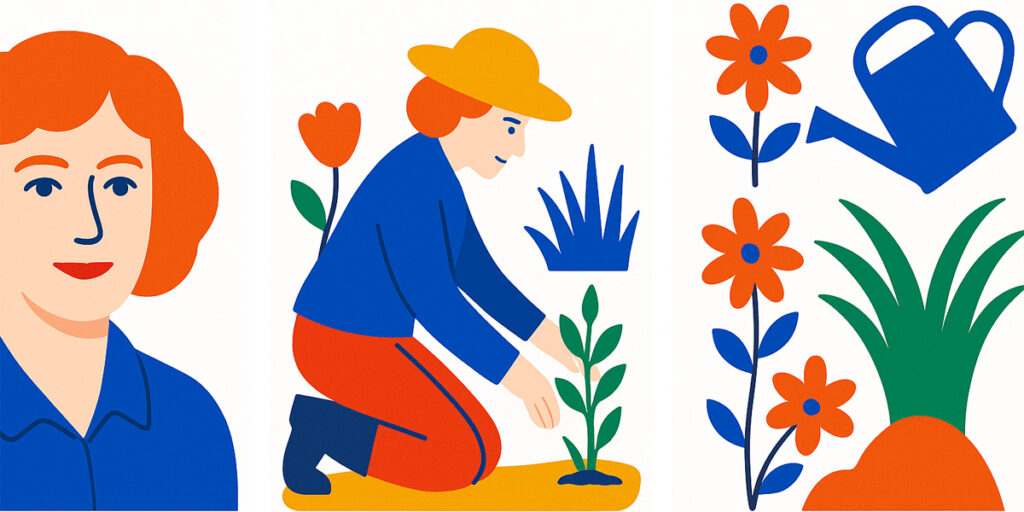Beth Chatto walked gently through the world, but she left a garden that speaks forever. Born into the quiet English countryside, her heart was tuned not only to the rhythm of seasons, but to the soul of the soil beneath her feet. From childhood, she listened to plants—watched how they struggled or thrived depending on where they rooted. While others dreamed of grand designs, she dreamed of harmony. She saw nature not as something to conquer but to understand. Her whole life became a conversation with the land.
In the sleepy village of Elmstead Market in Essex, Beth began crafting a world that many would later travel across oceans to see. She didn’t start with lush meadows or gentle rainfall. Her land was dry, unyielding, and stubborn. But Beth never fought it. She looked closely and asked one question: What plant belongs here? That question became her compass. That idea—“right plant, right place”—would quietly bloom into a philosophy that transformed gardens around the world.
Her early years were filled with observations more than declarations. She married Andrew Chatto, a botanist and thinker, whose plant collections and deep knowledge of wild flora became Beth’s second classroom. Together, they collected seeds, studied conditions, and slowly built not just a garden—but a living experiment. When Andrew passed away, Beth kept walking the garden paths they once walked together. Each tree, each herb, each drought-tolerant bloom carried echoes of their shared vision.
Beth’s garden wasn’t meant to impress with color bursts or exotic fads. It was meant to teach. It whispered lessons about patience, adaptability, and resilience. Her Gravel Garden, perhaps her most famous creation, was built on poor, dry soil—and yet it flourished without irrigation. This wasn’t magic. It was wisdom. Beth didn’t impose her desires on the land. She learned from it, and that learning invited abundance.
Visitors who stepped through the gate at the Beth Chatto Gardens discovered not only beauty but clarity. Here, every curve, every border, every flower held a story. Some were tough alpine species nestled between stones, others tall grasses bending in the wind. All had found their home. Her garden was not a showpiece. It was a love letter to ecology, a gentle rebellion against wasteful gardening, and a sanctuary for creatures that buzz, crawl, and sing.
Beth didn’t seek the spotlight, but it found her. Her lectures inspired young horticulturists. Her calm voice filled classrooms, her hands filled with soil, her eyes forever studying what worked where. As gardening trends came and went, Beth remained rooted. Her method wasn’t trendy. It was timeless. Her philosophy made sense in a warming world—planting responsibly, using water wisely, and respecting the natural order.
Her books became companions to gardeners everywhere. They weren’t mere manuals; they were memoirs of soil and stem. The Dry Garden spoke to those who faced parched ground with hope. The Damp Garden offered guidance for low-lying, soggy spots others had abandoned. Beth Chatto’s Green Tapestry painted a portrait of how textures, foliage, and form could create emotion in the garden. And her most moving work, Dear Friend and Gardener, a collection of letters with fellow plantsman Christopher Lloyd, offered a peek into her warmth, wit, and ever-evolving thinking.
Her writing, like her garden, had no excess. Every word, every plant had a purpose.
What made Beth extraordinary wasn’t just her knowledge. It was her character. She didn’t lecture; she shared. She didn’t chase fame; she nurtured understanding. Her presence was humble, her work revolutionary. Garden ecology became a field not of fancy theories but of practical beauty because she lived it, proved it, and showed it to the world.
And so, the Beth Chatto Gardens in Essex became not just a destination, but a vision for the future. Schools brought children. Designers brought sketchbooks. Scientists brought notebooks. But everyone left with the same lesson: listen to the land.
Long before sustainability became a movement, Beth was already walking that path in her well-worn boots, watering not just roots but minds. She taught people that success in a garden doesn’t come from imposing control, but from building trust—with the earth, the weather, and the wisdom of plants.
As years passed, her gardens continued to change. That was part of their soul. Plants died and returned. Trees reached toward new sunlight. New species were added, old ones celebrated. And Beth, now an icon, never stopped learning. She remained a student of her own garden, even into her final days.
When she finally stepped away from her life’s work, the garden did not freeze in time. It lived on, cared for by those who had learned under her guidance. And in every flower blooming exactly where it should, in every insect sheltered by a leaf, in every child kneeling to smell lavender, her legacy blooms.
Beth Chatto didn’t just build a garden. She sowed a philosophy. She grew a movement. She gave voice to plants and a future to landscapes forgotten by traditional design. And she did it not through spectacle or scale, but through quiet observation and steadfast love.
Today, her name lives in leaf and blossom, in books that carry her vision, and in gardens worldwide shaped by her humble but powerful idea: place the right plant in the right place—and everything else will follow.




















